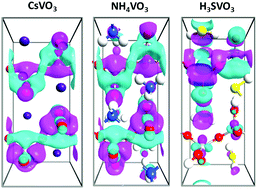Enhancing the electronic dimensionality of hybrid organic–inorganic frameworks by hydrogen bonded molecular cations†
Abstract
Transition-metal oxides with pyroxene structure, such as alkali-metal metavanadates, are known for their good chemical stability and have been used accordingly in many applications. In this work, we explore the possibility of enhancing the carrier transport and optoelectronic properties of hybrid inorganic–organic metavanadates MVO3 by introducing molecular cations. The hydrogen bonded molecular cations are found to enhance the electronic effective dimensionality of the system. This is related to the connectivity of the atomic orbitals to form new electron and hole transport channels. For the materials considered here, these channels are formed by hydrogen bonding that, besides enhancing the stability, results in enhanced macroscopic electronic transport and enhanced photo-generated carriers relaxation time. Our study indicates that the electronic dimensionality of the hybrid metavanadates could exceed their subnanometer structural dimensionality which is a desirable feature for improving their optoelectronic properties. This concept can be generalized to a wider class of hybrid organic–inorganic frameworks.

- This article is part of the themed collection: Materials Horizons 10th anniversary regional spotlight collection: Africa and the Middle East


 Please wait while we load your content...
Please wait while we load your content...